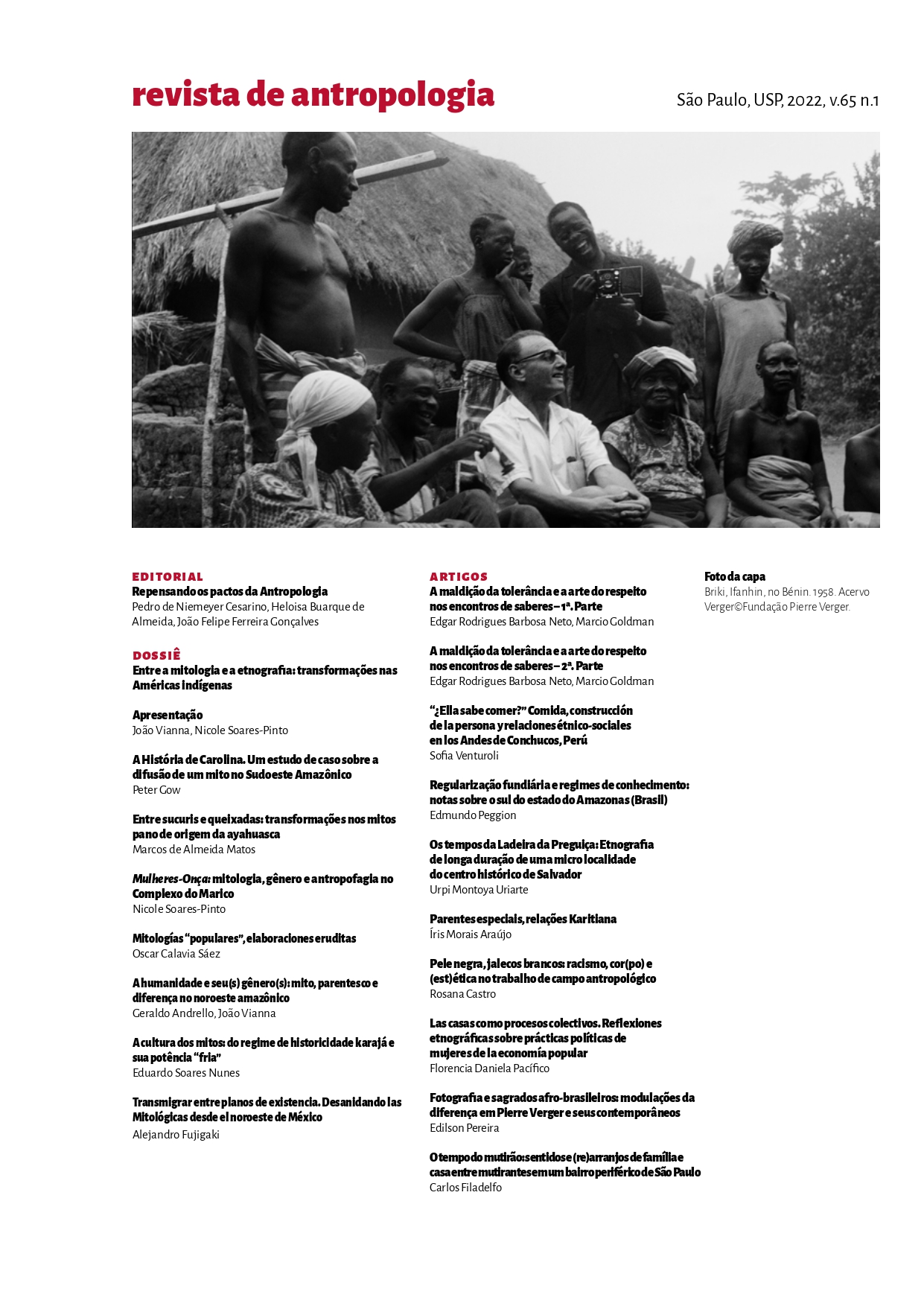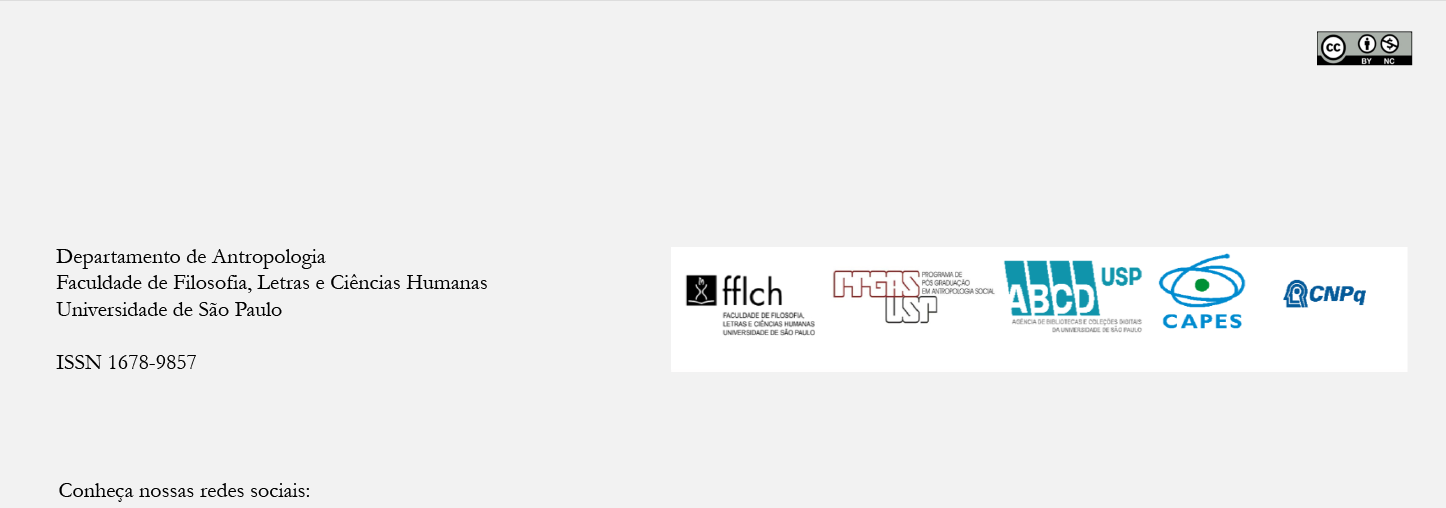Humanity and its gender(s): myth, kinship and difference in the Northwest Amazonia
DOI:
https://doi.org/10.11606/1678-9857.ra.2022.192786Keywords:
Northwest Amazonia, Myth, kinshipAbstract
This article aims to articulate two ethnographic investigations, among the Tukano and Baniwa, that address the relations between kinship and myth. The aim is to understand the production of sociocosmological differences in the Northwest Amazonia from the mythical narratives of the origin of humanity. The analysis will follow the events that unfold from Jurupari, an extraordinary child and ceremonial artifact possessing reproductive capacities; from the snake-canoe, an animal-object-uter that manages humanity; from births in the waterfalls of Hipana and Ipanoré; from adultery with a snake-white man; and from the war between men and women. All these events, characters and relationships, articulate in a complex way transespecificity and cross-sex relationships. At the end, we hope to highlight these two distinct ways in which today's humanity is stabilized from a virtual background of alterity, noting the important tukano and baniwa transformations in the Upper rio Negro.
Downloads
References
ACEP. 2012. O que a gente precisa para viver e estar bem no mundo. v. 1 e 2, São Gabriel da Cachoeira, ACEP. Disponível em <https://issuu.com/instituto-socioambiental/docs/manejo_pamaali_portugues> acesso em 20 de abril de 2016.
ANDRELLO, Geraldo. 2006. Cidade do Índio. Transformações e cotidiano em Iauareté. São Paulo, Editora UNESP- ISA; Rio de Janeiro, NUTI.
ARHEM, Kaj; CAYÓN, Luis; ANGULO, Gladys; GARCIA, Maximiliano. 2004. Etnografia makuna: tradiciones, relatos y saberes de la gente de água. Bogotá, Acta Universitatis Gothenburgensis & Instituto Colombiano de Antropología e Histooria.
BARBOSA RODRIGUES, João. 1890. Poranduba Amazonense. Anais da Biblioteca Nacional do Rio de Janeiro, vol. 14, n. 2. Disponível em: http://memoria.bn.br/pdf/402630/per402630_1980_00100.pdf acesso em 23 de agosto de 2021.
BAYARU, Tõrãmu; YE NI, Guahari. 2004. Livro dos antigos Desana – Guahari Diputiro Porã. São Gabriel da Cachoeira, ONIMRP/FOIRN.
BELAUNDE, Luisa Elvira. 2006. A força dos pensamentos, o fedor do sangue. Hematologia e gênero na Amazônia. Revista de Antropologia vol. 49, n. 1: 205-243. DOI https://doi.org/10.1590/S0034-77012006000100007
BOLLENS, Jacqueline. 1967. Mythe de Jurupari – Introduction à une analyse. L’Homme, vol. 7, n.1: 50-66. https://doi.org/10.3406/hom.1967.366858
BRANDÃO DE AMORIM, Antonio. 1987 [1926]. Lendas em Nheengatu e em Português. Manaus, Fundo Editorial - ACA.
CABALZAR, Aloísio. 2008. Filhos da Cobra de Pedra: organização social e trajetórias tuyuka no rio Tiquié (noroeste amazônico). São Paulo, Editora da Unesp/ISA/NuTI.
CARDOSO, Júlio. [s/d]. Novo Milênio: as histórias e a vida de Júlio Cardoso Awadzoro. São Gabriel da Cachoeira, [s/e]. (mimeo)
CAYÓN, Luis. 2013. Pienso, logo creo. La teoria Makuna del mundo. Bogotá, Instituto Colombiano de História y Antropologia.
CHERNELA, Janet. 1988. “Rethinking history in the Northwest Amazon. Myth, structure, and history in an Arapaço narrative”. In.: HILL, Jonathan D. (éd.), Rethinking History and Myth. Indigenous South American Perspectives on the Past. Urbana, University of Iillinois Press, pp. 35-49.
CORNELIO, José; FONTES, Ricardo; SILVA, Manuel. 1999. Waferinaipe Ianheke. A Sabedoria dos Nossos Antepassados. Histórias dos Hohodene e dos Walipere-Dakenai do rio Aiari. Coleção Narradores Indígenas do Rio Negro. São Gabriel da Cachoeira, FOIRN.
DIAKURU [Américo Castro Fernandes); KISIBI (Durvalino Moura Fernandes). 1996. A mitologia sagrada dos Desana-Wari Dihputiro Põrã. São Gabriel da Cachoeira, UNIRT/FOIRN.
FONTES, Francineia. 2019. Hiipana, eeno hiepolekoa: construindo um pensamento antropológico a partir da mitologia Baniwa e de suas transformações. Rio de Janeiro, Dissertação de mestrado, Museu Nacional da Universidade Federal do Rio de Janeiro.
GARNELO, Luiza. 2002. Poder, Hierarquia e Reciprocidade: saúde e harmonia entre os Baniwa do Alto Rio Negro. Campinas, Tese de doutorado, Universidade Estadual de Campinas.
GARNELO, Luiza; ALBUQUERQUE, Gabriel; SAMPAIO, Suelly; BRANDÃO, Luiz Carlos. (Orgs.) (2005). Cultura, escola, tradição: mitoteca na escola Baniwa. Manaus, RASI/UFAM.
GENTIL, Gabriel. 2000. Mito Tukano. Quatro Tempos de Antiguidades. Zurich/Basel, Waldgut.
HILL, Jonathann. 1993. Keepers of Sacred Chants. The Poetics of Ritual Power in an Amazonian Society. Tucson, The University of Arizona Press.
HILL, Jonathann. 2009. Made from Bone. Trickster Myths, Music, and History from the Amazon. Urbana/Chiacago, University of Illinois Press.
HILL, Jonathan; CHAUMEIL, Jean-Pierre (Orgs). 2011. Burst of Breath: New Research on Indigenous Ritual Wind Instruments in Lowland South America. Lincoln, University of Nebraska.
HUGH-JONES, Christine. 1979. From the Milk River. Spatial and Temporal Processes in North-west Amazonia. Cambridge, Cambridge University Press.
HUGH-JONES, Stephen. 1979. The Palm and the Pleiades: Initiation and Cosmology in North-west Amazonia. Cambridge, Cambridge University Press.
HUGH-JONES, Stephen. 1995. “Inside-out and back-to-front: the androgynous house in Northwest Amazonia”. In: CARSTEN, Janet; HUGH-JONES, Stephen (eds.), About the house. Lévi-Strauss and Beyond. Cambridge: Cambridge University Press. pp.226-252.
HUGH-JONES, Stephen. 1996. Resenha de La paix des jardins: Structures sociales des Indiens curripaco du haut Rio Negro (Colombie), de Nicolas Journet. American Anthropologist, vol. 98: 672–673. DOI https://doi.org/10.1525/aa.1996.98.3.02a00510
HUGH-JONES, Stephen. 2001. “The Gender of some Amazonian Gifts: An Experiment with an Experiment”. In: GREGOR, Thomas; TUZIN, Donald. (eds.), Gender in Amazonia and Melanesia. Berkeley: University of California Press. pp. 245-278.
HUGH-JONES, Stephen. 2013. Bride-service and the absent gift. Journal of the Royal Anthropological Institute, 19/2: 356-377. https://doi.org/10.1111/1467-9655.12037
HUGH-JONES, Stephen. 2019. Thinking through Tubes: Flowing H/air and Synaesthesia. Tipití: Journal of the Society for the Anthropology of Lowland South America: Vol. 16: n. 2: 20-46.
JACKSON, Jean. 1983. Fish People. Linguistic exogamy and Tukanoan identity in Northwest Amazonia. Cambridge: Cambridge University Press
JESUS, Adriano de; JESUS, Pedro de; Aguiar, Luís. 2018. Ennu Ianáperi. História dos Tariano pelo clã Koivathe. São Gabriel da Cachoeira, COIDI/FOIRN.
JOURNET, Nicholas. 1995. La paix des jardins: Structures sociales des Indiens curripaco du haut Rio Negro (Colombie). Paris, Institut D’Ethnologie, Musée de L’Homme.
JOURNET, Nicholas. 2006. Sacred Flutes as the Medium for an Avowed Secret in Curripaco Masculine Ritual. Sevilla, 52nd International Congress of Americanists.
KARADIMAS, Dimitri. 2008. La métamorphose de Yurupari: flûtes, trompes et reproduction rituelle dans le Nord-Ouest amazonien. Journal de la Société des Americaniste, vol. 94, n. 1: 127-169. DOI https://doi.org/10.4000/jsa.9253
KELLY, José. 2005. Notas para uma teoria do “virar branco”. Mana – Estudos de Antropologia Social, vol. 11, n.1: 201-234. DOI https://doi.org/10.1590/S0104-93132005000100007
LÉVI-STRAUSS, Claude. 2004. O Cru e o Cozido. São Paulo, Cosac Naify.
MAIA, Arlindo; ANDRELLO, Geraldo. 2019. Ye'pâ-Di'iro-Mahsã, gente de carne da terra: os Tukano do rio Vaupés. Mundo Amazónico, 10(1): 53-81.
MAIA, Moisés; MAIA, Tiago. 2004. Yekisimia Masîke’. O conhecimento dos nossos antepassados. Uma narrativa Oyé. São Gabriel da Cachoeira, COIDI/FOIRN.
MICH, Tadeusz. 1994. The Yuruparí Complex of the Yucuna Indians. The Yuruparí Rite Source. Anthropos, vol. 89, n. 1/3: 39-49. Disponível em https://www.jstor.org/stable/40463193, acesso em 23 de agosto de 2021.
NAHURI [Miguel Azevedo] & KUMARÕ [Antenor Azevedo]. 2003. Dahsea Hausirõ Poã ukushe wiophesase merã bueri turi. Mitologia sagrada dos Tukano Hausirõ Porã. São Gabriel da Cachoeira, UNIRT/FOIRN.
PANLÕN KUMU, Umusi [Firmiano Arantes Lana]; KEHÍRI, Tõrãmu [Luiz Gomes Lana]. 1995. Antes o mundo não existia. Mitologia dos antigos Desana-Kehíripõrã. São Gabriel da Cachoeira, UNIRT/FOIRN.
RAMIREZ, Henri. 2001. Dicionário Baniwa Português. Manaus, Ed. Universidade do Amazonas.
REICHEL-DOLMATOFF, Gerardo. 1996. Yuruparí: studies of an Amazonian foundation myth. Cambridge/Massachusetts, Harvard University press.
REID, Howard. 1979. Some aspects of movement, growth and change among the Hupdu Maku indians of Brazil. Cambridge, Tese de doutorado, University of Cambridge.
ROJAS, Filintro. 1997. Ciencias naturales em la mitología Curripaco. Guainia, Fundación Etnollano.
SAAKE, Wilhelm G. 1976. “O mito do Jurupari entre os Baníwa do rio Içana”. In SCHADEN, Egon. (org.), Leituras de Etnologia Brasileira. São Paulo, Companhia Editora Nacional. pp. 277-285.
SCOLFARO, Aline, OLIVEIRA, Ana Gita; HERNÁNDEZ, Natalia; GÓMEZ, Silvia. 2014. Cartografia dos Sítios Sagrados. São Paulo, Instituto Socioambiental.
SORENSEN, Arthur. 1967. Multilingualism in the Northwest Amazon. American Anthropologist, vol.69, n.6: 670-684. DOI https://doi.org/10.1525/aa.1967.69.6.02a00030
STRATHERN, Marilyn. 1988. The Gender of the Gift. Cambridge, Cambridge University Press.
STRADELLI, Ermano. 2009. Lendas e notas de viagem. A Amazônia de Ermano Stradelli. São Paulo, Martins Fontes.
VIANNA, João. 2017. Kowai e os Nascidos: a mitopoese do parentesco Baniwa. Florianópolis, Tese de doutorado, Universidade Federal de Santa Catarina.
VIANNA, João. 2020. A coafinidade baniwa: descrições e modelos no Noroeste Amazônico. Maloca. Revista de Estudos Indígenas, vol. 3, n. 1: e020009. DOI https://doi.org/10.20396/maloca.v3i.13502
VIVEIROS DE CASTRO, Eduardo. 2002. “O problema da afinidade na Amazônia” In: VIVEIROS DE CASTRO, Eduardo. A inconstância da alma selvagem. São Paulo, Cosac e Naify, pp. 87-180.
VIVEIROS DE CASTRO, Eduardo. 2007a. Filiação intensiva e aliança demoníaca. Novos estudos CEBRAP. Vol. 77: 91-126. DOI https://doi.org/10.1590/S0101-33002007000100006
VIVEIROS DE CASTRO, Eduardo. 2007b. “Xamanismo transversal, Lévi-Strauss e a cosmopolítica amazônica”. In: QUEIROZ, Rubem Caixeta de; NOBRE, Renarde Freire (org). Lévi-Strauss: leituras brasileiras. Belo Horizonte: UFMG, pp.87-136.
WAGNER, Roy. 2010. A invenção da cultura. São Paulo, Cosac e Naify.
WRIGHT, Robin. 1993-1994. Umawali. Hohodene myths of the Anaconda, father of fish. Bulletin de la Société Suisse des Américanistes, Genebra, v. 57/58: 37-48. http://www.sag-ssa.ch/bssa/pdf/bssa57-58_05.pdf
WRIGHT, Robin. 2013. Mysteries of the jaguar shamans of the northwest Amazon. Lincoln, University of Nebraska Press.
WRIGHT, Robin. 2017. As tradições sagradas de Kuwai entre os povos aruaque setentrionais: estruturas, movimentos e variações. Mana – Estudos de Antropologia Social, vol. 23, n. 3: 609-652. DOI https://doi.org/10.1590/1678-49442017v23n3p609
Downloads
Published
Issue
Section
License
Copyright (c) 2022 Revista de Antropologia

This work is licensed under a Creative Commons Attribution 4.0 International License.
Authors who intend to publish in this journal must agree with the following terms:
- a) Authors retain copyright and grant the journal the right of first publication. The work is simultaneously licensed under the Creative Commons Attribution License, which allows the work to be shared as long as the author and the initial publication in this journal are appropriately credited.
- b) Authors are authorized to sign additional contracts for non-exclusive distribution of the version of the work published in this journal (e.g., to publish it as a book chapter), as long as the author and the initial publication in this journal are appropriately credited.
- c) Authors are allowed and encouraged to publish and distribute their work online (e.g. on their personal webpage) after the editorial process, for this can generate productive changes as well as increase the impact and citation of the work. See The Effect of Open Access Publications.




